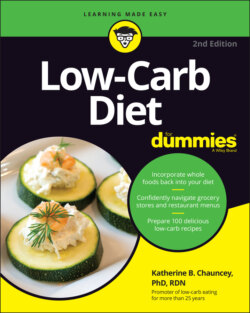Читать книгу Low-Carb Diet For Dummies - Katherine B. Chauncey - Страница 30
Evaluating the Controversy
ОглавлениеThe low-carb diet gained modern-day popularity about 50 years ago only to later be squelched by the fully accepted and heavily promoted low-fat diet. Cholesterol was implicated as a major determinant of heart disease, and diets high in saturated fat were found to raise blood cholesterol levels. Lowering fat intake in the diet enjoyed approval by the scientific community and was embraced by national health organizations and public policy. There was a halo-effect over the low-fat diet and horns and a devil’s fork over fat. Fat was branded as the ultimate dietary villain, for several reasons:
Heart disease was increasing and was correlated with high cholesterol. Scientists discovered that saturated fat increased cholesterol levels in the blood. Scientists also sensed that people were slowly becoming a little fatter. A fat gram contained twice the number of calories of protein or carbohydrate grams, so a good way to reduce the number of calories people ate was to reduce the number of fat grams consumed.
Fat was also blamed for cancer and a host of other diseases.
The low-fat diet approach enjoyed almost universal acceptance and respect from the scientific community and the public. Fat in any form was demonized. And, the concept of low fat being healthy became deeply ingrained in society. Along with the lowering of fat in the diet was the recommendation to replace the fat with carbohydrate foods that were virtually devoid of fat.
Then the low-carbohydrate diet started making another comeback with not only its good results in blood glucose and weight loss, but also good results in blood cholesterol parameters. Media headlines questioned the honesty of the low-fat diet, and nutrition scientists were accused of waffling on their nutrition advice. Obesity was worse than ever, now at epidemic proportions; cancer was also just as bad as ever, accompanied by increases in diabetes, high blood pressure, joint pain, and heartburn. Heartburn became more sophisticated and was renamed gastroesophageal reflux disease (GERD). And a “new” disease phenomena appeared on the scene dastardly labeled at first as Syndrome X and later as metabolic syndrome. Metabolic syndrome is actually the manifestation of insulin resistance and is considered a strong risk factor for heart disease. (Check out Chapter 4 for more information on metabolic syndrome.) Accusers pointed directly at carbohydrate as the villain. The low-fat diet, which recommended carbohydrate as a substitute for fat, was dealt a blow. Even the United States Department of Agriculture’s Food Pyramid was included as an enabler and was eventually eliminated.
So, where is the truth? Is it the very-low-fat diet? No. Is it the very-low-carb diet? No. Do people need to eat less fat? Yes. Do people need to eat less carbohydrate? Yes. In fact, people need to eat less of just about everything. In the era of the very-low-fat-diet or very-low-carb diet, eating was relegated to math. You were allowed 20 grams of fat or 30 grams of carbohydrate depending on which plan you followed. So, the only important thing was how many grams of fat or carbohydrate were in the food. The quality of the food didn’t matter.
Two other factors played a role in this nutritional thinking:
Scientists discovered the glycemic index to evaluate carbohydrate quality. The glycemic index measures equal quantities of carbohydrates on blood glucose levels. Refer to Chapter 3 and Appendix A for more information.
Healthcare providers now use not only total cholesterol value to assess heart disease risk, but also a lipid profile to evaluate other cholesterol factors in the blood. A lipid profile includes the following:Total cholesterolLow density cholesterol (LDL)High density cholesterol (HDL)Triglycerides (TG)
Flip to Chapter 4 for more about cholesterol and triglycerides. The following sections discuss the fallacies in the low-fat and low-carb dietary approaches. They encourage you to start looking at the quality of the food you eat and not just how many grams of fat or carb the food contains.
